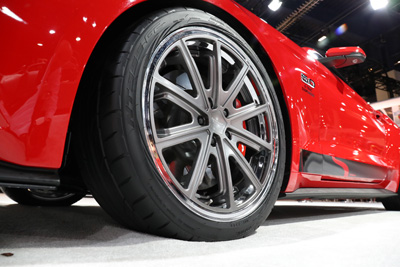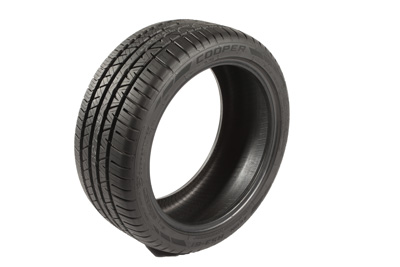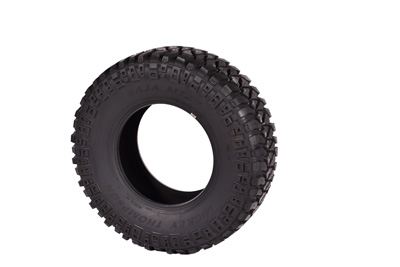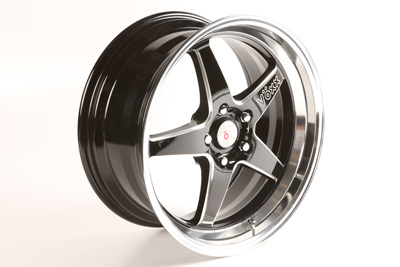SEMA News—February 2017
BUSINESS
Wheel and Tire Market Trends
Less Is More and Bigger Is Better
Continental Tire’s Marketing Director Travis Roffler recently spoke with SEMA News about winter tire trends and new products. |
There’s a reason why the tire and wheel section remains one of the largest display areas of the annual SEMA Show in Las Vegas. For consumers, tires and wheels continue to be one of the first, best and most basic ways to personalize a passenger car or light truck. Whether enhancing looks and stance from the get-go or breathing new life into a well-traveled vehicle, consumers love their wheel-and-tire packages. And through a variety of performance and style options aimed at every taste, the specialty-equipment industry stands readier than ever to fulfill their custom desires.
Currently, the “2016 SEMA Market Report” estimates the performance tire aftermarket at $1.95 billion and the wheel aftermarket at $3.2 billion. The bulk of tire sales is concentrated in the midrange/traditional vehicle and pickup categories at 21% and 23% respectively. However, CUV and SUV aftermarket tires combined represent just over $30% of sales as well. Not surprisingly, sales tend to be concentrated in the hands of online and brick-and-mortar auto parts chains, big-brand tire shops and independent specialty stores. Wheel sales closely mimic those patterns, although sports car designs sell at a slightly higher rate than wheels tailored specifically to light trucks.
 The aftermarket can expect to see the wheel and tire segments continue with steady and evolutionary (as opposed to revolutionary) growth in 2017, according to industry experts. With tires, less rolling resistance is the goal, while larger-size wheels are here to stay.JHGKJHGHGFHJGFJHGFHGFJGFD |
When it comes to off-road and plus-size tires, however, the market figure jumps to a whopping $3.73 billion, with 39% of sales going to pickups. Midrange and traditional vehicle sales make up 17% of the aftermarket, with CUV/SUV tires again hitting just short of 30% combined.
Entering 2017, automotive experts say that the aftermarket can look for continued growth throughout all of those wheel and tire categories. However, don’t go looking for any groundbreaking technologies or product innovations from manufacturers in the coming year. Rather, expect the ongoing refinement of two basic agendas set by automakers and best summed up by the phrases “less is more” and “bigger is better.”
The Tire Market
Propelled by tightening Corporate Average Fuel Economy standards, the big automakers are adopting the less-is-more philosophy for tires—as in less rolling resistance. Consequently, this is quickly becoming the mantra for tire makers as well, said Bob Ulrich, editor of Modern Tire Dealer.
“All of the tire manufacturers are working on reducing rolling resistance in tires, since the more freely tires roll, the less energy is needed to move the vehicle forward, obviously improving fuel economy,” Ulrich explained. “However, low-rolling-resistant tires are not yet a trend on the consumer level. The more fuel-efficient a tire is, the more trade-offs there are in other performance areas, such as wet traction and tread wear. And if that isn’t enough to discourage consumers, fuel-efficient tires tend to cost more.”
Automobile magazine Editor-in-Chief Mike Floyd concurred: “As hybrids and EVs start to further proliferate and OEMs attempt to squeeze every last mpg out of internal-combustion, higher-mileage, appliance-type vehicles, low-rolling-resistance tires are becoming increasingly common. Some of the models are Conti Contact, Michelin Energy, Bridgestone Ecopia and Goodyear Eagle LS. I don’t think consumers really understand or care necessarily, as long as they last and don’t ride harshly.”
As they aim for the sweet spot between low resistance and quality ride, tire manufacturers are adjusting their strategies and refining existing technologies. In the short term, expect to see inflation pressures continue to increase even as overall tire profiles and sidewalls become lighter, more stylized and more aerodynamic as OEMs further integrate tires into whole-vehicle designs that achieve fuel economy while catching consumer eyes.
In the background, tire manufacturers will also be at work on smarter tire-pressure monitoring systems that can detect and warn against insufficient tread depth as well as when tires are exceeding their load-bearing capabilities. Sensors embedded in the tire tread itself may also soon aid onboard computers in adjusting weight-bearing and various driver-assist functions as vehicles become more fully automated.
 The all-new Cooper Zeon RS3-G1 is an example of the movement toward truer and much more capable all-season tires. Its wide, flat tread arc is designed for a more stable footprint, with grip that can hold the road in tight cornering at greater lateral force. |
“There is no revolution going on in the tire industry right now,” Ulrich said. “Everything is evolving, from the manufacturing processes to the tires being produced. Tire plants are more automated than ever before, but they still need more than a few skilled workers to produce a tire. With that said, the tires being produced are more, if you will pardon the pun, well-rounded than ever before. For example, yesterday’s all-season tire was really closer to a three-season tire, with little performance in the winter. That is not the case anymore. Also, tire manufacturers have been able to blend the wet and dry handling characteristics of ultra-high-performance [UHP] tires with the ride comfort and low-road noise requirements of touring tires. The UHP touring tire is definitely a trend in the aftermarket.”
 The recovering economy continues to entice off-roaders back to their favorite pastimes, revitalizing the market for mud-terrain tires such as the new Mickey Thompson Baja MTZP3. |
Ironically, amid the push for more fuel-efficient tire designs, Floyd also expects to see sales increase in the super-sport segment.
“There’s been a proliferation of what amounts to track tires being made available as an option tire for even affordable super sports cars such as the Corvette,” he explained. “[All of the manufacturers] want to see their cars painted in a positive light during magazine testing, especially at the track, and invariably they send along the cars with the option tire. Michelin Pilot Super Sport, Pirelli P Zero, Goodyear Eagle F1s are among the usual suspects there.”
Moreover, with the recovering economy, consumers are also returning to familiar pastimes—a trend made evident by truck tires.
“At this year’s Global Tire Expo, mud-terrain [M/T] tires were the rage,” Ulrich noted. “Manufacturers and marketers that had previously offered only highway-terrain [H/T] and all-terrain [A/T] tires were showcasing M/T tires. There were even a number of extreme M/T tires on display. With consistently low gas prices, it looks like enthusiasts are spending more time off road.”
The classic/restoration tire segment, although only a fraction of the tire market, is also making gains as consumers again wax nostalgic for showcase vehicles. However, this segment has special challenges requiring highly specialized solutions.
“For some restorers and car owners who strive for the ultimate in authenticity, nothing but New Old Stock [NOS] or original tires will do,” observed Drew Hardin, editor of Hot Rod Deluxe and Muscle Car Review magazines. “A larger segment of our readership is fine with the reproduction tires on the market. They look just like the bias-ply Goodyears, Firestones and the like of 50 and 60 years ago—because many of them are made on the same, vintage molds—but they’re constructed of modern materials and many—but not all—have to pass Department of Transportation regulations, so they’re much safer to drive on than old tires.
“The major tire reproduction companies—Coker and Kelsey—do a good job of offering correct tires for a variety of eras and makes—the proper sizes, sidewall designs, lettering fonts and so on. They’ve also been pretty responsive to market demands for filling gaps in sizes of the tires that they offer.”
Jess Hoodenpyle, vice president of sales for Coker Tires, confirmed that the restoration/classic market continues to grow.
“We have seen especially strong growth in the popularity of many of the late-’60s and early-’70s musclecars,” he said. “Another market that is expanding is classic trucks. Early-’70s Chevrolet C10s and GMCs have been increasing in popularity, and now that is spreading into other trucks such as the Ford F100 and Dodge D200.”
In fact, to address the growing musclecar market, Coker Tire has recently rolled out a new bias-look Firestone Wide Oval radial that the automotive press is hailing as a “true game changer.” Offering consumers the appearance of bias-ply tires with radial construction that delivers contemporary ride, handling, safety and tread life, the product covers a 10-year range of automobiles from ’64–’74 and no limits to custom applications.
Of course, no survey of the growing tire market would be complete without noting the increasing number of foreign brands flooding the market and stiffening competition for established tire makers.
“Because of low labor costs, a number of countries, including China, can manufacture products much less expensively than the United States. can,” Ulrich said. “Tariffs on imported goods help, but the bottom line is that consumers often can save money buying imports rather than buying American. Based on assurances made during the recent presidential campaign, however, the incoming administration seems focused on correcting that imbalance. In the case of tires in the aftermarket, U.S. manufacturing gave up low-cost radial production years ago, opening the door for manufacturers from low-cost countries to fill the ‘good’ or ‘value’ segment of the market.”
The Wheel Market
 The sport performance market is also growing for tire offerings such as Goodyear’s Eagle F1 SuperCar tire, which offers ultra-high performance and plenty of dry traction. |
“As for wheels, bigger is better for OEMs,” Floyd observed. “Eighteens are now becoming commonplace on even compact crossovers, with 20s becoming more of the norm for bigger sedans. Everyone wants to fill up the wheelwells and increase presence, but that can mess with the ride at times. Bigger does not always mean better from a ride and handling standpoint. Wheel style is an ever-greater consideration as well to make an automaker’s car stand out in crowded market segments. The Alfa Romeo Giulia Quadrofoglio sport sedan, for example—which is solid-looking but not exceptionally so—has some of the most amazing cloverleaf-look wheels. I’m betting that’s going to sell a couple of those cars on that alone.”
Making their cars stand out with bigger and better wheels is becoming even more important for aftermarket consumers, too, said Gavin Horlick, vice president of Voxx Products, a major manufacturer of multiple wheel brands for the North American market.
“As always, wheels are among the first items that people accessorize,” he said. “But what we’re seeing is not just a younger performance-oriented person or a nostalgic hot-rod car builder but more of your mainstream consumers of tire products who are changing and accessorizing their wheel options as well.”
On the truck side, Horlick said that a growing percentage of business is coming from dealerships, which are increasingly adding suspension lifts with new tires-and-wheel packages and wrapping those accessories into the vehicle sticker price. However, on the passenger-vehicle side, consumers are still mainly waiting to upgrade their wheels with their first set of tires.
“Typically their vehicle is two to four years old; they like the vehicle; they don’t want a new car yet; but they want to change it up,” Horlick said, adding that today’s consumers almost always first research online, where they can digitally model wheel styles for their vehicles. Purchases are then typically made at a respected retail tire center.
Meanwhile, just as it is for OEMs and tire makers, the ongoing pursuit of wheel manufacturers continues to be lessening rolling resistance by combining strength with weight savings through a variety of approaches. Recently, racing wheel manufacturer Forgeline Motorsports entered a partnership with Emergent Carbon Wheels to launch its Carbon+Forged Series, a new line of two-piece carbon-fiber and forged-aluminum ultra-high-performance wheels.
 The never-ending search for the magic combination of lightness and strength is leading to aftermarket innovations such as Forgeline’s new two-piece Carbon+Forged Series, which features CNC machine-forged aluminum centers and carbon-fiber barrels. |
“I see the wheel market going toward exclusivity and customization,” said David Schardt, the company’s president. “Everyone has a slightly different opinion on what looks good, and they will pay extra to get exactly what they want. Carbon fiber is the most sought-after material in any performance product in the aftermarket. Besides its awesome strength and weight characteristics, carbon fiber is equated with pure performance and exclusivity, and its distinctive looks make it easy to spot.
“OE manufacturers are starting to use wheels that are 100% carbon fiber on their high-end cars, such as the Ford GT. This will continue to drive the aftermarket toward carbon fiber. However, a wheel made entirely of carbon fiber leaves no room for customization and needs a mold for every single size, bolt pattern and offset. Our wheels with the aluminum center are available in two diameters, eight widths and almost unlimited amounts of offsets and bolt patterns. The center can be customized with an array of finish options as well.”
Of course, in the hierarchy of the wheel market, forged two- and three-piece products continue to occupy the upper echelon, while cast aluminum represents the wide-ranging choice of the more money-conscious buyer. Introduced more recently, however, flow-form manufacturing has steadily dropped in price, bringing costs down almost on par with traditional cast wheels. The manufacturing process creates a cast-aluminum wheel while elongating and stretching the barrel, making it thinner, stronger and lighter.
“There’s some performance benefit to this new process that’s becoming more mainstream,” said Horlick. “For the performance consumer, there’s less rotational mass for the tire and wheel assembly, which allows a vehicle to accelerate and decelerate faster, so there are advantages for a consumer to upgrade and personalize a car as well as get a little bit better performance out of it.”
The progressions toward bigger wheel sizes and flow-form manufacturing are also rippling through the high-performance market, according to Alan Peltier, president of HRE Performance Wheels.
“I think we’re seeing the same general trend that we’ve always seen, which is people moving to bigger diameters,” he said. “In a lot of cases, that’s driven by the OEMs with bigger wheels to begin with. In our market, it’s getting to exotics with 20-in. wheels, so you can’t put on anything smaller than 20s. We’re seeing 21 in. doing similar volume to 19 in., with 20s still being the majority. When I started at HRE 17 years ago, 17 or 18 in. was the norm.”
While the trend toward bigger wheels is mostly driven by styling and OEM designs raising vehicle beltlines, the larger carbon-ceramic brakes on today’s high-performance cars are also a factor.
“We can’t fit 19 in. on many of the applications anymore,” Peltier said.
Yet as wheel manufacturers race to keep up with OEM designs, Peltier noted that tire manufacturers have typically lagged in supplying larger tire designs, presenting difficulties for the performance sector.
“They’re a little bit behind, and it can be frustrating,” he observed. “We will lose sales because the tires aren’t available. When Michelin or Pirelli come out with a bigger tire, we’ll sometimes buy them and keep them in stock, even though we aren’t in the tire business, in case our customers need them.
“On the cast wheel side, flow form was really the only option for us. When we started looking at a cast wheel, we wanted a lower-cost line that we could offer as a [viable] product, and we felt that flow form was really important to minimize mass. From our experience, the product is very robust. To us, it’s the best way to make a cast wheel.”
Back at Voxx, Horlick noted that concave wheel designs—another trend that hit the market several years ago—are also demonstrating real staying power, thanks especially to bigger OEM brake assemblies.
“Aftermarket wheels can’t accommodate them and still fit under the fenders,” he explained. “I think it’s kind of a transition. In terms of application, making a concave wheel is better from a manufacturing standpoint, and it just happens to be a trend right now as well.”
Schooling the Market
 Flow-form manufacturing continues to spread throughout the wheel aftermarket, with Voxx now offering its new Aria line, the only flow-formed staggered fitment wheel available in the United States with a rolled front lip. |
With such a plethora of wheel and tire technologies becoming more widespread and new players constantly rushing into the market, industry sources said that a knowledgeable counter person will be more vital than ever in assisting consumers who face a bewildering array of choices.
“Future technology is especially becoming a hot-button issue,” said Allan Keefe, SEMA senior manager of councils and the liaison to the SEMA Wheel and Tire Council (WTC). “For autonomous driving, the size of a wheel or tire combination can raise or lower a car, so your driver-assist and backup cameras, distance and parallel parking sensors, speedometer and other systems are going to be altered. Everything with a car starts from the ground, and that’s going to mean wheels and tires.”
In past years, the WTC produced a “Ride Guide” to educate the aftermarket on differing wheel and tire fitments and their effects on car and truck ride and handling characteristics. Now the council is putting the finishing touches on a brochure that retailers can share with consumers to help them properly clean and maintain their wheels. All the while, the council continues to promote industry wheel and tire standards and best practices.
Ultimately, sales will rest on retailers who are well studied in OEM and aftermarket trends, Horlick concluded: “It’s going to be their job to be honest with consumers and to find and decipher the information from the manufacturers to properly weight it for consumers.”





